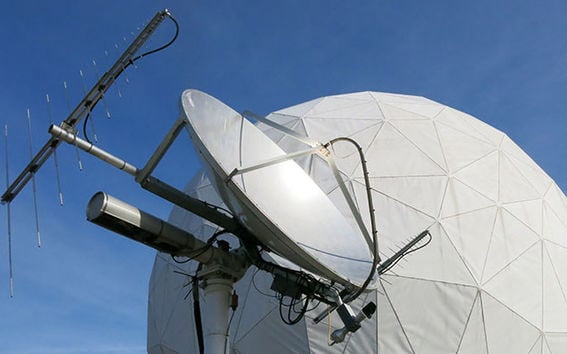Radio telescope captures solar eclipse even from behind the clouds

On Friday 20 March an almost total solar eclipse will be tracked in Finland and in Aalto University's Metsähovi Radio Observatory. The solar eclipse will begin at 11:00 and end at 13:00.
Located in Metsähovi is Finland's only astronomical research radio telescope. Even if the weather is cloudy during the solar eclipse, the Metsähovi radio telescope is able to capture the solar charts.
'This is the second time that a solar eclipse is being followed, and the first time that it is being done from the beginning to the end of the eclipse', explains Metsähovi Director Joni Tammi.
Although solar eclipses are not a new phenomenon, their monitoring is important in case any unusual situations arise.
'If, for example, a solar flare takes place during the eclipse, the observations made using various techniques would be of great scientific significance.'
Moon to briefly become a part of the observation device
Unlike normal, the solar eclipse will be visible in Finland during the middle of the day, and this gives the opportunity to research the event from an energy generation viewpoint.
'The production of solar energy ceases of course every night, but the sudden eclipse will cause a much greater drop in production than the gradually darkening evening. Finland has relatively little solar energy, but in Central Europe, for example, an 80 percent eclipse would be equivalent to four out of the five solar energy power stations being turned off. The sudden and localised drop in temperature associated with the eclipse also causes changes to wind energy and wind speed', says Tammi.
The benefits gained by astronomy from solar eclipses are due to the influence of the moon.
'When the moon moves in front of the sun, different parts of the sun's surface and hot corona surrounding it are hidden for different observation frequencies. By following the dimming and brightening of the sun with different frequencies, we are able to research the composition of different regions close to the surface of the sun.'
Solar eclipse observations are also important for the study and development of research equipment.
'We will use the moon's sharp edge to help us improve the resolution of our radio telescope. We will focus on the sun's active areas and try to establish with radio frequencies their size and composition using the extra precision provided by the moon. If we don't succeed, the next opportunity will be in 2018.
Cooperation in solar eclipse monitoring
Because Finland is a large country, it's important to make observations throughout the whole length of the country. The visibility of the solar eclipse is best in Kilpisjärvi, where observations will be taken by the Sodankylä Geophysical Observatory in cooperation with Metsähovi. In the north, data will be collected using a Kaira radio observation device.
'Solar eclipses have taken place as long as the sun and the moon have been in existence. They have been a source of wonder in all cultures throughout history, and eclipses are even known to have ended wars. We are dealing with an event which causes all people to think about the scale of the universe we live in, and our part in it', Tammi adds.
Nowadays the phenomenom is entirely understood, but with its help we can still research obscure and hidden aspects of solar activities.
The data collected during the day and the related links will be updated online in almost real time at www.metsahovi.fi/sun/eclipse_2015 (in Finnish). The solar eclipse can also be followed on Twitter at #metsahovi.
Further information:
Joni Tammi, Metsähovi Director
[email protected]
tel. 029 4424 858
blogs.aalto.fi/metsahovi
facebook.com/metsahovi
Picture: Joni Tammi
Read more news

DeployAI Partners Gather for Heart Beat Meeting in Helsinki
The European DeployAI project's partners gathered for the Heart Beat meeting hosted by Aalto University Executive Education in Helsinki.
Get to know us: Associate Professor Maria Sammalkorpi
Sammalkorpi received her doctorate from Helsinki University of Technology 2004. After her defence, she has worked as a researcher at the Universities of Princeton, Yale and Aalto.
Aalto computer scientists in ICML 2024
Computer scientists in ICML 2024